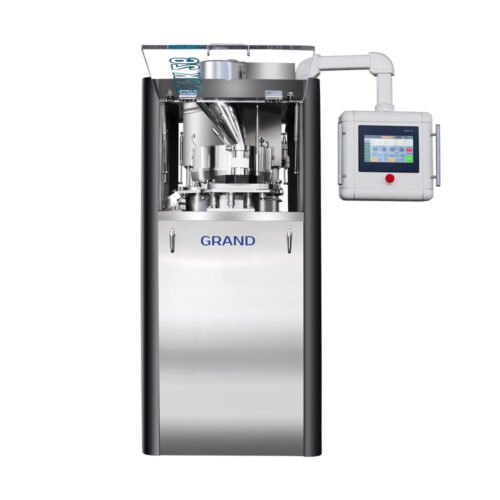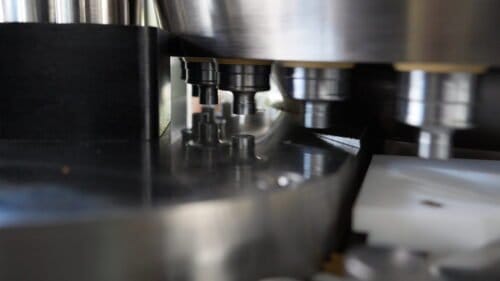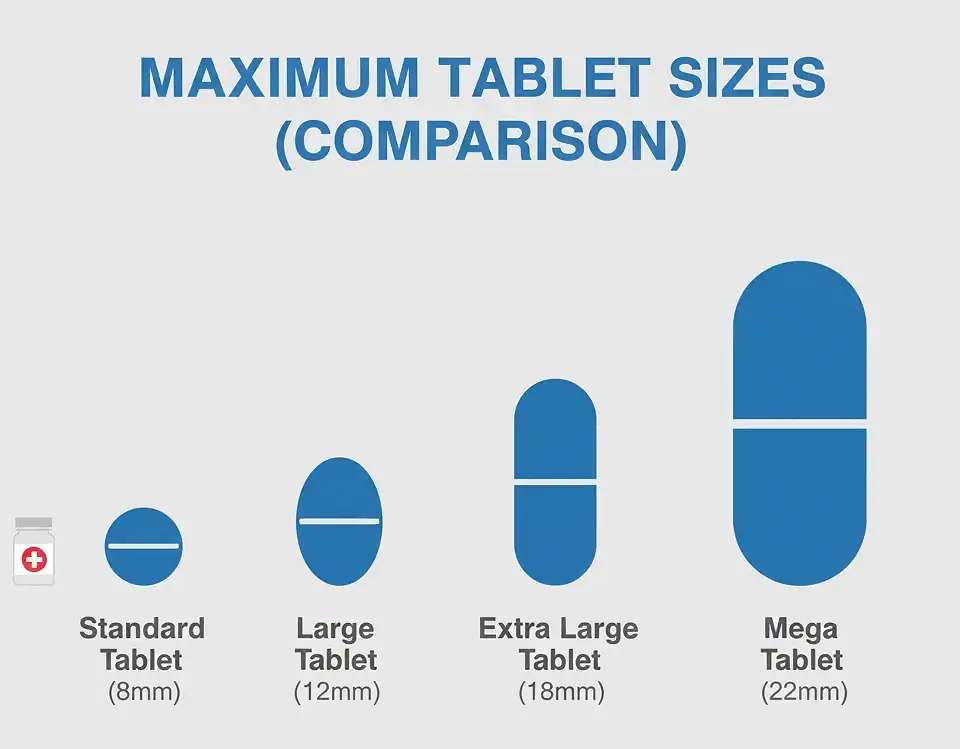
Cost of a Liquid Filling Machine: A Comprehensive Guide

The Sweet Science of Gummy Candy: More Than Just a Chewy Treat
The Ultimate Rotary Tablet Press Buying Guide 2025
Introduction: Bridging Drug Delivery Innovation and Manufacturing Reality
The field of drug delivery is constantly evolving, driven by the core goal of improving therapeutic outcomes—enhancing efficacy, reducing toxicity, boosting patient compliance, and even enabling entirely new medical treatments. The global drug delivery market is projected for significant continued growth, reflecting the industry's urgent need for better solutions.
Cutting-edge research delves into complex delivery mechanisms. For instance, a recent study in Nature Communications explored how the "protein corona" forming on the surface of lipid nanoparticles (LNPs)[1]influences their targeting, delivery, and ultimate fate within the body. Understanding these nanoscale interactions is critical for developing next-generation therapies like mRNA vaccines or targeted cancer drugs.

Yet, despite the rise of sophisticated delivery systems like sustained-release matrices and PEGylation , the humble tablet remains a cornerstone of the pharmaceutical and nutraceutical industries. Why? Tablets offer excellent stability, are relatively easy to produce, boast long shelf lives, and often have lower production costs than many other dosage forms. These factors make tablets crucial for managing chronic conditions and improving patient adherence.
However, the effectiveness of even the most innovative drug formulation ultimately depends on precise, reliable, and efficient manufacturing. This brings us to the workhorse of tablet production: the rotary tablet press, often simply called a pill presser or tablet press machine. As formulations become more complex (e.g., incorporating sustained-release technology , optimizing immediate release , handling sensitive active pharmaceutical ingredients (APIs) ), the demands on production equipment increase, requiring greater precision and reliability to ensure the drug performs as intended. This guide is designed to give you a deep dive into rotary tablet presses, empowering you to make an informed purchasing decision in 2025.

Grand Table Press Machine
Decoding the Rotary Tablet Press: Your High-Volume Tablet Solution
A rotary tablet press is a highly specialized, automated piece of machinery widely used in industries like pharmaceuticals, nutraceuticals, and related fields such as herbal supplements, chemicals, and food processing.
Its core function is to compress powder or granular materials into tablets of uniform size, shape, weight, and density. The "rotary" aspect is key: multiple pressing stations (consisting of punches and dies) are mounted on a rotating turret. This design enables continuous, high-speed operation, distinguishing it sharply from single-punch presses that produce one tablet at a time. Rotary presses can achieve massive outputs, producing tens or even hundreds of thousands of tablets per hour.
Modern rotary tablet presses are typically highly automated, offering precise control over the entire tableting process. This automation isn't just about speed; it's crucial for ensuring consistent product quality, which is vital for meeting stringent regulatory requirements like Current Good Manufacturing Practices (cGMP). Automation minimizes the potential for human error and allows for real-time monitoring and adjustment of key parameters, guaranteeing batch-to-batch consistency.
Inside the Machine: Key Components of a Rotary Tablet Press
Understanding the main parts of a rotary tablet press helps visualize how it works. Here are the core components that power the tablet production process:
- Hopper: Located at the top of the machine, the hopper holds the powder or granular material used for tablet production. It guides the material into the machine, often via gravity or vibration. The hopper's design is crucial for ensuring a continuous, steady feed of material. Poor flow from the hopper can lead to issues like tablet weight variation.
- Feeder System: This system is responsible for accurately and uniformly filling the die cavities on the turret with material from the hopper. Common types include gravity feeders and force feeders. Force feeders (often using paddles) are essential for ensuring complete and consistent die filling, especially with poorly flowing or specialized powders , significantly improving fill accuracy and production efficiency.
- Punches and Dies (Tooling): These are the heart of tablet formation. Punches come in pairs – upper and lower. Dies contain the cavities where the powder is compressed. The punch tip shape determines the tablet's size, shape, and any debossing (like score lines or logos). The material of the tooling (e.g., hardened steel ) affects its durability.
- Turret: The rotating component that holds the punches and dies, ensuring their precise alignment throughout the compression cycle. The turret's continuous rotation drives the entire process of filling, metering, compression, and ejection. The turret's design dictates the number of stations on the machine, influencing its maximum production capacity.
- Compression Rollers: These apply pressure to the punches, which in turn compress the powder within the die cavities. Typically includes pre-compression and main compression rollers. Pre-compression rollers apply an initial, lighter force primarily to expel air trapped between powder particles and form a preliminary compact. This helps prevent defects like capping (top separating) or lamination (splitting into layers) during main compression.
- Ejection Mechanism: Responsible for removing the finished tablets from the die cavities. This usually involves an ejection cam that lifts the lower punch as the turret rotates. The rising lower punch pushes the tablet out of the die. A take-off blade (or scraper) then guides the ejected tablet off the die table and into a discharge chute.

These components work synergistically to form an efficient, precise tablet production system. Understanding their interdependence is crucial: for example, smooth hopper flow is a prerequisite for accurate filling, while a high-quality force feeder can compensate for poor material flow. Powerful compression rollers require robust tooling and a stable turret for support. Therefore, evaluating a rotary tablet press requires a holistic assessment of all key components and their integration, not just focusing on a single specification.
The Process Unveiled: How a Rotary Tablet Press Makes the Perfect Pill
The operation of a rotary tablet press is a continuous cycle driven by the turret's rotation. This process can be broken down into the following key stages:
Stage 1: Filling The tableting process begins with filling. Powder or granules flow from the hopper into the feeder system. As the turret rotates, the die cavities pass under the feeder, and material is uniformly fed into each die. The lower punch is in a low position at this point, creating the necessary volume within the die cavity to accept the material.
Stage 2: Metering (Dosing) The goal here is precise control over the amount of material in each die cavity. The lower punch rises to a predetermined height, defining the fill volume (the dose). Excess material is scraped off the die table, ensuring a consistent amount in each cavity. This step is critical for guaranteeing uniform tablet weight.
Stage 3: Compression Compression begins as the filled and metered dies rotate under the compression rollers. This typically occurs in two steps :
- Pre-compression: The upper and lower punches move towards each other under the influence of the pre-compression rollers, applying an initial, moderate pressure to the material in the die. The primary purpose is to expel trapped air from the powder bed, preventing capping or lamination defects during main compression, and to form an initial, denser compact. Pre-compression force can be substantial (e.g., up to 20 kN ) and is particularly important for ensuring tablet quality at high production speeds.
- Main Compression: Subsequently, the punches pass under the main compression rollers, subjecting the material to significantly higher pressure. This force consolidates the particles into the final tablet with the desired hardness, thickness, and density. The duration the punches spend under maximum pressure (dwell time) can be adjusted based on the formulation's characteristics. High main compression capability (e.g., 80-100 kN ) is necessary for compressing some difficult formulations.
Stage 4: Ejection After compression, the upper punch retracts upwards. Then, guided by the ejection cam, the lower punch rises within the die, pushing the finished tablet out of the die cavity onto the surface of the die table. A take-off blade then sweeps the tablet off the turret into a discharge chute. During or after this stage, some machines incorporate dedusting systems to remove fine powder adhering to the tablet surface. If the machine has an automatic rejection system, defective tablets (e.g., incorrect weight, visual flaws) are automatically removed at this point.
Rotary Tablet Press Type Comparison Table
Choosing Your Press: Rotary vs. Single Punch Tablet Press
Besides rotary presses, another common type of tablet press machine is the single punch tablet press (also known as an eccentric press). Understanding the differences between these two is crucial for selecting the right equipment.
A single punch press has a simpler construction, featuring only one pressing station with a single die cavity and one pair of upper and lower punches. It completes one cycle of filling, compression, and ejection per single rotation of its cam, producing one tablet at a time.
Here’s a comparison of key characteristics between rotary and single punch presses:
- Production Scale:
- Single Punch: Best suited for small batch production, research and development (R&D), laboratory preparations, and pilot-scale trials. Its value lies in preparing experimental batches and developing formulations.
- Rotary: Designed for medium to large-scale production, serving as the workhorse for industrial manufacturing in the pharmaceutical and nutraceutical sectors.
- Complexity & Operation:
- Single Punch: Simple design, relatively easy to operate with minimal training required; can be manual or semi-automatic.
- Rotary: Complex design, typically requires more extensive training for operation and maintenance; usually fully automated systems.
- Production Capacity (Output):
- Single Punch: Low output, producing one tablet per cycle.
- Rotary: High output, achieving tens to hundreds of thousands of tablets per hour through multiple stations working simultaneously.
- Tablet Uniformity:
- Single Punch: May exhibit slight variations in tablet weight and hardness within a batch.
- Rotary: Employs advanced control technology to produce tablets with high consistency in weight, hardness, and dimensions.
- Compression Force:
- Single Punch: Compression force is typically moderate, suitable for basic formulations.
- Rotary: Generally capable of applying higher compression forces, allowing processing of a wider range of formulations, including difficult-to-compress ones.
- Flexibility & Changeover:
- Single Punch: Changeover concept is not applicable or very simple due to the single station design.
- Rotary: Designed for quick tooling or turret changes, facilitating efficient switching between different products or specifications.
- Cost:
- Single Punch: Lower initial investment and maintenance costs, suitable for limited budgets or beginners.
- Rotary: Higher initial investment, but the cost per tablet can be lower in large-scale production due to high efficiency and capacity.
- Feature Comparison Table: Rotary vs. Single Punch Tablet Press
Choosing between these types isn't solely about batch size. Single punch presses offer invaluable flexibility and ease of use during drug development and formulation screening. Rotary tablet presses, conversely, are engineered for stable, efficient, large-scale production demands. While the initial investment for a rotary press is higher , its high throughput and automation features can significantly reduce unit costs in large-scale operations, leading to greater economic efficiency.
Quality Matters: Why Invest in a High-Performance Pill Presser (Featuring Grand Advantages)
Once you've determined the need for a rotary tablet press, the next critical decision involves the quality and performance level of the machine. Why is investing in a high-performance rotary tablet press so important? It's not just about speed; it's fundamentally about final product quality, production reliability, and long-term economic benefits.
High-quality, high-performance rotary pill pressers typically offer the following advantages:
- Superior Precision & Consistency: This is the core value. They ensure every tablet produced is highly consistent in weight, dimensions, and hardness, which is critical for accurate dosage and overall product quality. This effectively minimizes batch-to-batch variation and addresses issues like weight fluctuations caused by poor material flow.
- High Speed & Efficiency: High performance often translates to faster production speeds, maximizing output, shortening production cycles, and thereby lowering the cost per tablet. This is crucial for meeting market demand and staying competitive.
- Advanced Controls & Automation: Modern high-performance presses feature sophisticated control systems (like PLCs and HMIs) allowing operators to precisely set, monitor, and log all critical process parameters. These systems support advanced functions like automatic weight control and defective tablet rejection , and lay the groundwork for advanced manufacturing concepts like Process Analytical Technology (PAT) or Continuous Manufacturing (CM).
- Durability & Reliability: High-quality machines use more robust construction and premium materials (e.g., corrosion-resistant turrets , hardened steel tooling ) and incorporate features like automatic lubrication systems for longer service life and lower failure rates, reducing costly downtime. They are built to withstand demanding continuous production environments.
- Versatility & Flexibility: High-performance presses are often better equipped to handle a wide variety of materials, including challenging formulations. Quick-change tooling or turret designs make switching between different products faster and more efficient. A wide range of adjustable parameters also increases adaptability.
- Compliance & Safety: Reputable brands typically design and build machines according to cGMP standards , ensuring regulatory compliance. They also incorporate comprehensive safety features like safety interlocks, emergency stop buttons, and turret guards. Effective dust control systems protect operators and prevent cross-contamination.
- Many features of high-quality presses—such as efficient force feeders, reliable pre-compression, high main compression force, and precise control systems—are specifically designed to address common tableting challenges like poor flow, sticking, picking, capping, lamination, and weight variation. Investing in quality equipment is, therefore, an investment in problem prevention and production stability.
Taking Grand brand tablet presses as an example, some of their highlighted strengths align well with the requirements of high-performance equipment. Based on available reviews and information, key advantages of Grand tablet presses include :
- Customizable Solutions: A standout feature is Grand's ability to provide solutions tailored to specific client needs. This might involve custom tooling, specific control system configurations, or speed settings optimized for a particular application. This flexibility is invaluable for meeting diverse and demanding production requirements where a one-size-fits-all approach may not deliver optimal performance. A machine tailored to a specific product or process can potentially offer better performance, efficiency, and quality than a generic model.
- High Efficiency and Precision: Grand machines are noted for their high efficiency and precision , which directly translate to consistent tablet quality and optimized production times—core metrics for high-performance presses.
- Excellent Customer Service: Strong customer support is cited as a key advantage for Grand. For complex and expensive equipment like rotary tablet presses, the supplier's support for installation, training, maintenance, and troubleshooting is critical. Reliable technical service can minimize downtime, ensure smooth operation, and maximize the equipment's lifespan and return on investment. Evaluating the manufacturer's support capabilities is therefore just as important as assessing the machine's technical specifications.
Your 2025 Buying Checklist: 6 Essential Questions Before Buying a Rotary Tablet Press
Purchasing a rotary tablet press is a significant capital investment. To ensure the chosen equipment meets both current and future needs, here is a checklist of 10 essential questions, based on the user query, to systematically evaluate potential options and make a more informed decision. Think of this not just as a feature list, but as a risk mitigation tool to avoid acquiring a machine that's under-specified, too costly to run, or lacks necessary support.
- What are your production capacity requirements? (Tablets per hour, per shift, per batch?) (User Query Q1)
- Why it matters: Ensures the machine can meet your current and foreseeable future production demands. Consider peak production needs.
- What types of materials and formulations will you process? (Powders, granules? Simple, complex, sticky, abrasive?) (User Query Q2)
- Why it matters: Determines the need for specific features like force feeders, special tooling materials, or higher compression force. Machine versatility is key if handling multiple products.
- What specific features and technologies are critical for your operation? (e.g., Pre-compression, automatic weight control, data logging, bi-layer capability, potential for PAT integration?) (User Query Q3)
- Why it matters: Matches machine capabilities to your quality standards, operational needs, and future technology integration plans.
- What is the budget and total cost of ownership? (Initial purchase price? Expected long-term costs for maintenance, tooling, energy, spare parts?) (User Query Q4)
- Why it matters: Balances upfront investment with ongoing operational expenses to calculate true ROI. Consider cost-effectiveness per tablet.
- What are the maintenance and cleaning requirements? (Recommended maintenance schedule? Ease of cleaning and changeover?) (User Query Q5)
- Why it matters: Directly impacts downtime, labor costs, and compliance (cGMP requires easy cleaning ). Look for designs facilitating quick changeover and cleaning.
- What level of operator training is required? (Does the vendor provide training for safe and effective operation/maintenance?) (User Query Q6)
Conclusion: Moving Forward with Confidence
Choosing the right rotary tablet press is a pivotal decision that will directly impact your production efficiency, product quality, and ultimately, your bottom line.
By understanding the core components, working principles, different types, and key performance characteristics of these machines , you are better equipped to make an informed choice. During evaluation, focus on both the technical specifications and performance of the machine itself, as well as the support and services offered by the manufacturer (as exemplified by Grand's customizable solutions and customer service ).
We hope the information and the buyer's checklist provided in this guide (Section 8) empower you to conduct a thorough assessment and select a pill presser that not only meets your current requirements but also supports your future growth, ensuring a solid foundation for producing high-quality pharmaceuticals and nutraceuticals efficiently.
References:
[1].Papatriantafyllou, M. Lipid nanoparticles with PDL1-encoding mRNA spread tolerance. Nat Rev Rheumatol (2025). https://doi.org/10.1038/s41584-025-01251-8





